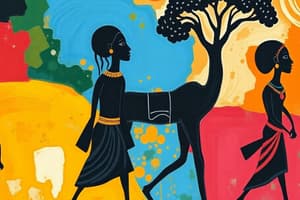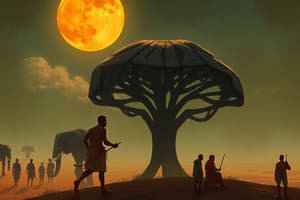Podcast
Questions and Answers
What does the timing of the Bantu migrations suggest about the agricultural practices in sub-Saharan Africa?
What does the timing of the Bantu migrations suggest about the agricultural practices in sub-Saharan Africa?
- Cattle herding was the only form of agriculture practiced in the area.
- Agricultural practices were adopted much earlier than in northern Africa.
- The agricultural revolution began simultaneously with foraging.
- Farming developed significantly later compared to other regions in Afro-Eurasia. (correct)
What was one significant outcome of the Bantu migrations across sub-Saharan Africa?
What was one significant outcome of the Bantu migrations across sub-Saharan Africa?
- The introduction of urban farming techniques from Asia.
- The formation of a widespread cultural and technological network. (correct)
- The establishment of deep-sea fishing communities.
- The isolation of various tribes due to geographical barriers.
Which area confirmed the presence of early farming techniques associated with Bantu-speaking peoples?
Which area confirmed the presence of early farming techniques associated with Bantu-speaking peoples?
- The eastern coastal regions of Africa.
- Central Africa near the Congo River.
- The highlands of Ethiopia.
- Northwestern modern-day Cameroon. (correct)
What is the historical significance of the Bantu migrations in terms of technological exchange?
What is the historical significance of the Bantu migrations in terms of technological exchange?
What method did ancient West African peoples primarily use to pass down knowledge before the Middle Ages?
What method did ancient West African peoples primarily use to pass down knowledge before the Middle Ages?
What role did divine kingship play in ancient Egyptian society?
What role did divine kingship play in ancient Egyptian society?
What construction achievement is associated with the centralized Egyptian government during the Old Kingdom?
What construction achievement is associated with the centralized Egyptian government during the Old Kingdom?
How did the ancient Egyptian state ensure sufficient food supply for laborers?
How did the ancient Egyptian state ensure sufficient food supply for laborers?
What essential component was necessary for the construction of the Pyramids?
What essential component was necessary for the construction of the Pyramids?
What was a consequence of periods of drought and famine in ancient Egypt?
What was a consequence of periods of drought and famine in ancient Egypt?
What function did the state perform in regard to religious beliefs in ancient Egypt?
What function did the state perform in regard to religious beliefs in ancient Egypt?
What was involved in the mummification process of ancient Egyptian rulers?
What was involved in the mummification process of ancient Egyptian rulers?
What was necessary for the construction of the largest pyramids in ancient Egypt?
What was necessary for the construction of the largest pyramids in ancient Egypt?
What geographic feature primarily influenced the division between Upper Egypt and Lower Egypt?
What geographic feature primarily influenced the division between Upper Egypt and Lower Egypt?
Which term refers to a government system where power is passed down through family?
Which term refers to a government system where power is passed down through family?
Who is often credited with unifying Upper and Lower Egypt around 3100 BCE?
Who is often credited with unifying Upper and Lower Egypt around 3100 BCE?
How many different dynasties ruled over Egypt from c. 3400 BCE to 30 BCE?
How many different dynasties ruled over Egypt from c. 3400 BCE to 30 BCE?
What does the term 'pharaoh' mean in ancient Egyptian language?
What does the term 'pharaoh' mean in ancient Egyptian language?
What were the major periods of stability in Ancient Egyptian history known as?
What were the major periods of stability in Ancient Egyptian history known as?
Which statement about the rulers of ancient Egypt is true?
Which statement about the rulers of ancient Egypt is true?
What characteristic defined the 'intermediate periods' in Ancient Egyptian history?
What characteristic defined the 'intermediate periods' in Ancient Egyptian history?
What was the primary purpose of mummification in Ancient Egypt?
What was the primary purpose of mummification in Ancient Egypt?
Which of the following best describes the social structure of Ancient Egyptian society?
Which of the following best describes the social structure of Ancient Egyptian society?
What can be inferred about the burial practices of commoners compared to elites in Ancient Egypt?
What can be inferred about the burial practices of commoners compared to elites in Ancient Egypt?
What role did peasants typically fulfill in Ancient Egyptian society during the farming off-season?
What role did peasants typically fulfill in Ancient Egyptian society during the farming off-season?
Which item was NOT typically associated with the trading practices of Ancient Egyptians?
Which item was NOT typically associated with the trading practices of Ancient Egyptians?
Who was primarily responsible for the mummification process in Ancient Egypt?
Who was primarily responsible for the mummification process in Ancient Egypt?
What was the primary economic role of the labor force in Ancient Egypt beyond farming?
What was the primary economic role of the labor force in Ancient Egypt beyond farming?
Which statement accurately reflects the funerary practices in Ancient Egypt?
Which statement accurately reflects the funerary practices in Ancient Egypt?
Which role did Hatshepsut NOT hold during her lifetime?
Which role did Hatshepsut NOT hold during her lifetime?
What was one significant action Hatshepsut took after becoming regent?
What was one significant action Hatshepsut took after becoming regent?
What was a major focus of Hatshepsut's reign?
What was a major focus of Hatshepsut's reign?
Why did Thutmose III possibly have Hatshepsut's temple and statues destroyed?
Why did Thutmose III possibly have Hatshepsut's temple and statues destroyed?
What does Hatshepsut's funerary complex reflect about her reign?
What does Hatshepsut's funerary complex reflect about her reign?
In which year did Hatshepsut die?
In which year did Hatshepsut die?
Which Pharaoh was Hatshepsut's stepson and successor?
Which Pharaoh was Hatshepsut's stepson and successor?
What major architectural project did Hatshepsut undertake?
What major architectural project did Hatshepsut undertake?
What was one way the Ancient Egyptian state acquired labor for its projects?
What was one way the Ancient Egyptian state acquired labor for its projects?
How did the role of women in Ancient Egyptian society compare to that in other ancient urban societies?
How did the role of women in Ancient Egyptian society compare to that in other ancient urban societies?
What led to the fragility and decline of the centralized Ancient Egyptian state?
What led to the fragility and decline of the centralized Ancient Egyptian state?
What was a significant change in governance after the decline of the New Kingdom?
What was a significant change in governance after the decline of the New Kingdom?
Which event marked the end of the last native Egyptian dynasty?
Which event marked the end of the last native Egyptian dynasty?
What cultural blend occurred in Alexandria after the rise of the Ptolemaic dynasty?
What cultural blend occurred in Alexandria after the rise of the Ptolemaic dynasty?
What was a consequence of the state's declining control over newly conquered lands?
What was a consequence of the state's declining control over newly conquered lands?
Which class of people in Ancient Egypt could sometimes avoid mandatory labor for state projects?
Which class of people in Ancient Egypt could sometimes avoid mandatory labor for state projects?
Flashcards are hidden until you start studying
Study Notes
Bantu Migration and Farming in Sub-Saharan Africa
- Foraging was prevalent in Africa until the development of advanced tools and crops led to the shift towards farming.
- Bantu migrations likely began around 2000 BCE and continued until 1000 CE, rapidly spreading across sub-Saharan Africa.
- By 1200 CE, a culturally and technologically interconnected Bantu presence existed throughout Africa.
- The Bantu expansion fostered extensive trade, cultural exchange, and shared agricultural practices across the continent.
- The agricultural revolution occurring in Afro-Eurasia around 8,000 to 10,000 years ago happened later in sub-Saharan Africa.
Evidence of Early Agriculture
- Examples of farming near modern-day Cameroon date back to approximately 7000 BCE.
- Foraging remained dominant in many regions until around 2000 BCE, delaying widespread agriculture.
- Ceramic styles analyzed by archaeologists assist in tracing the movement of Bantu-speaking populations and their agricultural practices.
- Linguistic studies of modern Bantu languages, such as Swahili, provide insights into the historical development and spread of the Bantu culture.
Theories on Bantu Migration
- Three main theories propose how the Bantu network developed: migration, diffusion, and adoption.
- Migration Theory posits large groups moved en masse, introducing agricultural technology and practices.
- Diffusion Theory suggests that small family groups spread Bantu technologies and language to neighboring areas without mass migration.
- Adoption Theory indicates locals integrated some Bantu technologies while retaining their original languages and practices.
Ongoing Questions and Research
- The narrative surrounding the agricultural revolution in sub-Saharan Africa remains incomplete.
- Scholars debate the specific migration routes of Bantu-speaking farmers and the motives behind their movements.
- Leonard Ngcongco highlights possible reasons for migration, such as population growth or resource depletion in original settlements.
- The continuity in decorative motifs across regions suggests a shared heritage and culture among ancient Bantu-speaking peoples.
Cultural Legacy
- Bantu-speaking groups left a significant impact on the cultural landscape of sub-Saharan Africa, observable in various artistic expressions and technological advancements.
- The archaeological and linguistic evidence continues to offer insights into their historical movement and integration into different environments across the continent.
Geography and Environment
- Extensive fishing, herding, hunting, and foraging contributed to the livelihood of ancient Egyptians.
- Settlements evolved into urban areas, primarily along the Nile, with Upper Egypt located in the south due to higher elevation.
- The Nile flows north into Lower Egypt, where the Nile Delta meets the Mediterranean Sea.
Political Structure
- Two distinct regions, Upper and Lower Egypt, each governed by separate rulers until unification around 3100 BCE.
- King Menes (or Narmer) is credited with uniting Egypt, marking an important political milestone.
- From c. 3400 BCE to 30 BCE, Egypt witnessed 30 different dynasties ruled primarily by pharaohs, who were often seen as divine figures linking humanity with the gods.
- Three primary periods of stability: Old Kingdom (c. 2649–2150 BCE), Middle Kingdom (c. 2030–1640 BCE), New Kingdom (c. 1550–1070 BCE), interspersed with intermediate periods of instability.
Construction and Governance
- The Pyramids of Giza reflect the centralized power of the Egyptian state, demonstrating advanced organization and resource management.
- Agriculture was centrally controlled to ensure food security, especially during droughts and famines.
- The state constructed levees and canals to enhance irrigation and manage floodwaters effectively.
Hatshepsut's Reign
- Hatshepsut was one of Ancient Egypt's most powerful female pharaohs, initially serving as regent for her stepson before declaring herself pharaoh.
- Expanded trade and culture during her reign, constructing an impressive funerary complex across from Thebes.
- Her legacy faced erasure after her death, as Thutmose III destroyed many of her statues.
Cultural Characteristics
- Mummification, mainly reserved for wealthy individuals, involved complex rituals intended to prepare the deceased for the afterlife.
- Egyptian society exhibited diversity and a hierarchical structure, with elites enjoying elaborate burials filled with goods while commoners had simpler interments.
Society and Labor
- The majority of commoners were free peasants who contributed labor as a form of taxation, particularly for state projects.
- Labor specialization included mathematicians, priests, artists, and administrators alongside farmers and builders.
- Egyptian women held more rights compared to other ancient societies, able to own property, conduct business, and participate in economic activities.
Decline and Transformation
- Egypt transitioned from a powerful centralized state to fragmented city-states due to costly wars of expansion during the New Kingdom.
- Following internal decline, foreign control by the Assyrians, Persians, Greeks, and Romans ensued.
- The last native dynasty fell to Alexander the Great in 332 BCE, leading to the establishment of the Ptolemaic dynasty, which combined Egyptian and Greek cultures in Alexandria until 30 BCE.
Studying That Suits You
Use AI to generate personalized quizzes and flashcards to suit your learning preferences.




